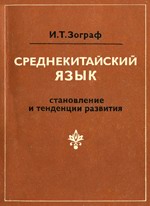|
|
| |

|

|
Zograph I.T. Middle Chinese: Its Formation And Development [Среднекитайский язык (становление и тенденции развития]. Moscow, Nauka, 1979.
SUMMARY
The book is an essay in describing Middle Chinese grammar in its historical perspective. The term refers to the variety of Chinese as “spoken” in the Sung and Yuan epochs — that which is usually considered to be the basic source of Modern Chinese (paihua).
The study is based on the sources now available, viz.: the collection of short stories Ching pen t'ungsu hsiaoshuo, the novel Shuei hu chuan, the so-called “Northern” plays tsachli, the “Southern” plays hsiwen. philosophical texts by Chu Hsi, the historical chronicle Yuan-ch'ao pi-shih.
The study takes into account the relevant literature in Russian, Chinese, Japanese and Western languages.
The Middle Chinese grammar is analysed against the background of the pertinent features of the T'ang epoch language as exemplified by Tunhuang pi en wen and T'ang texts yulu studied for the purpose. Due attention is paid to the subsequent development of the language towards Modern Chinese.
The goals of the study are explained in the Introduction where the language sources and the literature used are also described.
The bulk of the work is formed by the grammatical outline divided into sections. Each section is devoted to certain classeb of function words or to particular grammatical constructions, viz.: (1) Substitute words (personal pronouns, interrogative pronouns, demonstrative pronouns, predicative substitutes, number substitutes); (2) Verb quantifiers; (3) Negation markers; (4) Interrogation markers; (5) Conjuctions and prepositions; (6) Function words pa and chiang; (7) Passive verbs; (8) Causative constructions; (9) Clauses; (10) Sentence-final modal particles.
The speech-forms are analyzed along the historical line. Each such form is traced back to its earlier analogue and, whenever deemed necessary, the future development is taken into consideration as well.
The dynamic trends thus found in Middle Chinese are outlined somewhat more precisely by a special statistical study whose results are adduced in a number of tables attached to each section. This allows to present the crucial dynamic features in a clear-cut manner.
The final part sums up the major differences between Middle Chinese and Modern Chinese.
An Index of the function words and grammatical constructions analyzed is attached.
 PDF-files PDF-files
Аннотация, Введение, Summary, Содержание
Keywords
Chinese linguistics
Middle Chinese
|
|
|
|
Random news: Announcements |
|
On February 19, 2025, the IOM RAS will host the annual Iranological Conference in memory of O. F. Akimushkin. The program of the Conference is now available. |
|
Read more...
|
|
|
|
|

